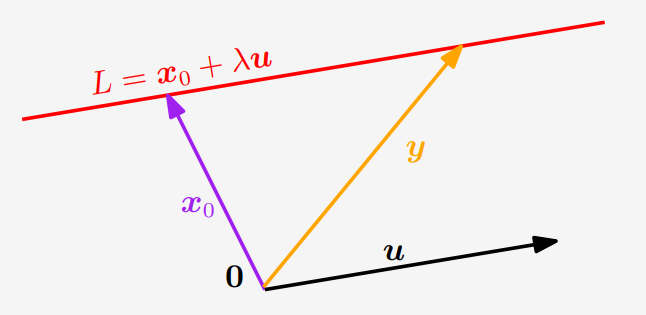Affine Spaces
이번 장에서는 원점을 뺀 spaces에 대해 살펴보도록 합니다. 즉, spaces는 더 이상 vector의 subspaces가 아닙니다. 또한, affine spaces(아핀 공간) 간의 mapping의 성질에 대해 살펴봅니다. 참고로 이 성질은 linear mapping과 유사합니다.
Afine Subspaces
Definition 2.25 (Affine Subspaces). $V$ 가 vector space이고, $\boldsymbol{x}_0 \in V$ 그리고 $U \subseteq V$ 라고 합시다. 그러면, 다음의 subset $L$ 을
\[\begin{align*} L &= \boldsymbol{x}_0 + U := \lbrace \boldsymbol{x}_0 + \boldsymbol{u} : \boldsymbol{u} \in U \rbrace \tag{2.130a} \\ &= \lbrace \boldsymbol{u} \in U | \exists\boldsymbol{u} \in U : \boldsymbol{v} = \boldsymbol{x}_0 + \boldsymbol{u} \rbrace \subseteq V \tag{2.130b} \end{align*}\]$V$ 의 affine subspaces 또는 linear manifold 라고 부릅니다. $U$ 는 direction 또는 direction space 라고 하며, $\boldsymbol{x}_0$ 은 support point 라고 합니다. 12장에서는 이러한 subspace를 hyperplane 이라고 칭합니다.
만약 $\boldsymbol{x}_0 \notin U$ 이면, affine subspace에 $\boldsymbol{0}$ 이 포함되지 않습니다. 따라서, affine subspace는 linear subspace가 아니며 $V$ 의 subspace가 아닙니다.
$\mathbb{R}^3$ 에서의 affine subspacs의 examples로는 points, lines, planes가 있으며 이들은 원점을 통과하지 않으며, 통과할 필요도 없습니다.
Example 2.26 (Affine Subspaces)
- 1차원 affine subspaces를 lines(직선)이라고 하며, $\boldsymbol{y} = \boldsymbol{x}_0 + \lambda\boldsymbol{x}_1$ 과 같이 작성합니다. 이때, $\lambda \in \mathbb{R}$ 이며, $U = \text{span}\lbrack\boldsymbol{x}_1\rbrack \subseteq \mathbb{R}^n$ 는 $\mathbb{R}^n$ 의 1차원 subspace 입니다. 즉, line은 support vector $\boldsymbol{x}_0$ 과 방향(direction)을 정의하는 벡터 $\boldsymbol{x}_1$ 로 정의됩니다. 아래 그림은 1차원 affine subspaces를 보여줍니다.
- $\mathbb{R}^n$ 의 2차원 affine subspaces는 planes(평면) 이라고 부릅니다. 평면의 parametric equation은 $\boldsymbol{y} = \boldsymbol{x}_0 + \lambda_1\boldsymbol{x}_1 + \lambda_2\boldsymbol{x}_2$ 이며, 이때, $\lambda_1, \lambda_2 \in \mathbb{R}$ 이고 $U = \text{span}\lbrack\boldsymbol{x}_1, \boldsymbol{x}_2\rbrack \subseteq \mathbb{R}^n$ 입니다. 즉, 평면(plane)은 support point $\boldsymbol{x}_0$ 과 direction space를 span하는 2개의 linearly independent vector $\boldsymbol{x}_1, \boldsymbol{x}_2$ 로 정의됩니다.
- $\mathbb{R}^n$ 에서 (n-1)-차원 affine subspaces는 hyperplanes라고 부르며, parametric equation은 $\boldsymbol{y} = \boldsymbol{x}_0 + \sum_{i=1}^{n-1}\lambda_i\boldsymbol{x}_i$ 입니다. 이때, $\boldsymbol{x}_1, \dotsc, \boldsymbol{x}_{n-1}$ 은 (n-1) 차원 subspace $U$ 의 basis를 형성합니다. 즉, hyperplanes는 support vector $\boldsymbol{x}_0$ 과 (n-1)개의 linearly independent vectors $\boldsymbol{x}_1, \dotsc, \boldsymbol{x}_{n-1}$ 로 정의되며, $\boldsymbol{x}_1, \dotsc, \boldsymbol{x}_{n-1}$ 는 direction space를 span 합니다.
Affine Mappings
Vector spaces 간의 linear mapping과 유사하게 두 affine spaces 간의 affine mapping을 정의할 수 있습니다. Linear mapping과 affine mapping은 많이 연관되어 있으며, 따라서 우리가 알고 있는 많은 속성(e.g. composition of linear mappings is linear mapping)들을 affine mapping에서 확인할 수 있습니다.
Definition 2.26 (Affine Mappings). Vector spaces $V, W$ 가 있고, linear mapping $\Phi : V \rightarrow W, \boldsymbol{a} \in W$ 일 때, 다음의 mapping을 V에서 W로의 affine mapping 이라고 합니다.
\[\begin{align*} \phi : &V \rightarrow W \tag{2.132} \\ & \boldsymbol{x} \mapsto \boldsymbol{a} + \Phi(\boldsymbol{x}) \tag{2.133} \end{align*}\]벡터 $\boldsymbol{a}$ 는 $\phi$ 의 translation vector라고 부릅니다.
Affine mapping은 다음의 성질들을 가지고 있습니다.
- 모든 affine mapping $\phi : V \rightarrow W$ 는 linear mapping $\Phi : V \rightarrow W$ 와 translation $\tau : W \rightarrow W$ in $W$ 의 조합입니다. 즉, $\phi = \tau\circ\Phi$ 입니다. 그리고 $\Phi$ 와 $\tau$ 는 유일합니다.
- Affine mappings $\phi : V \rightarrow W, \phi’ : W \rightarrow X$ 의 조합 $\phi’\circ\phi$ 도 affine 입니다.
- Affine mapping은 기하학적 구조를 유지하며, dimension과 parallelism 또한 보존합니다.
